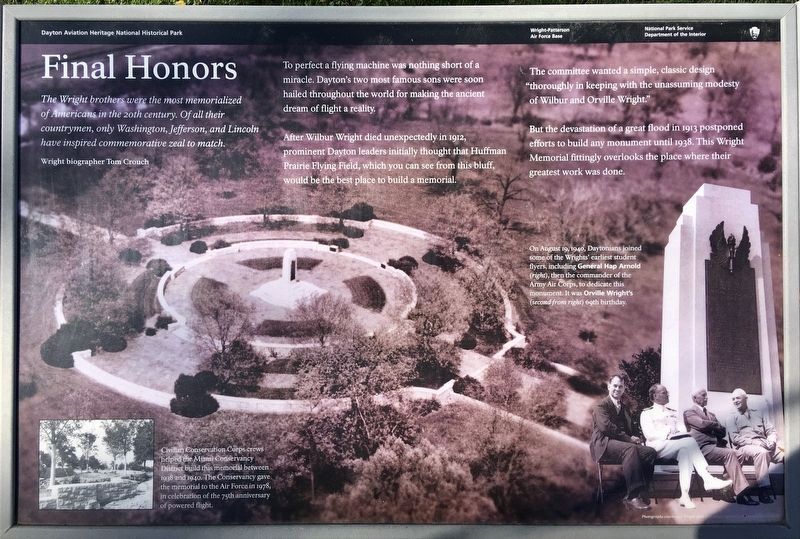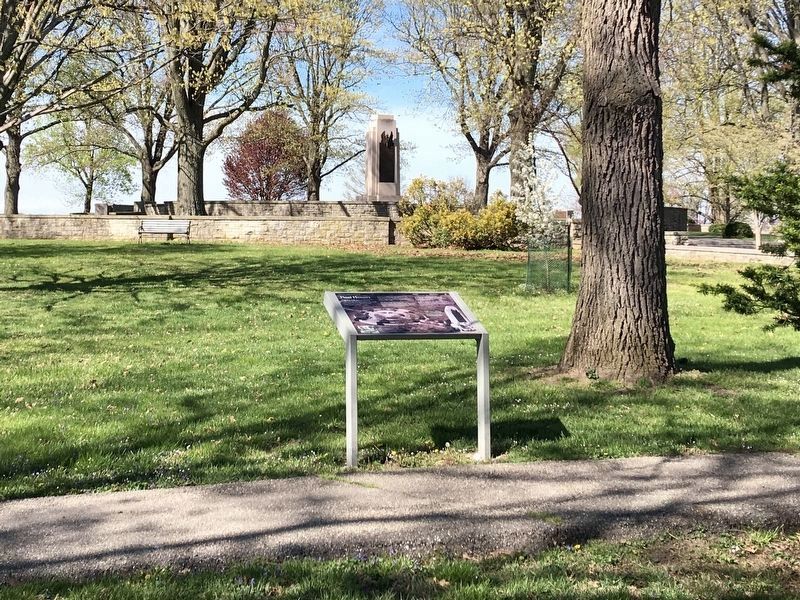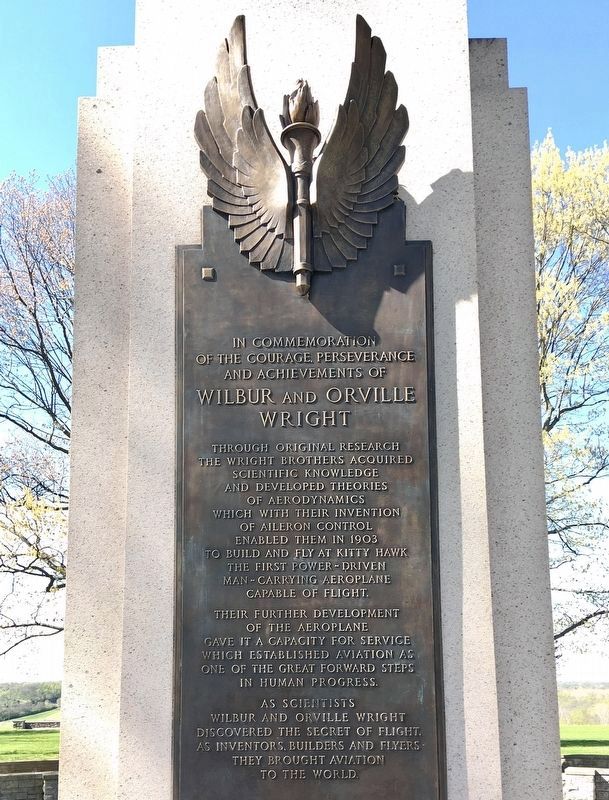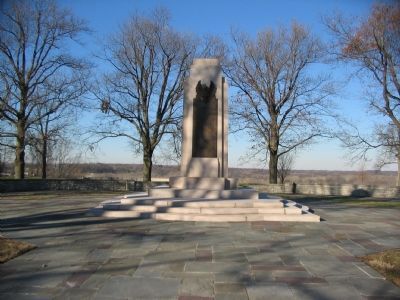Near Wright-Patterson Air Force Base in Greene County, Ohio — The American Midwest (Great Lakes)
Final Honors
Dayton Aviation Heritage National Historical Park
— National Park Service, U.S. Department of the Interior —
The Wright brothers were the most memorialized of Americans in the 20th century. Of all their countrymen, only Washington, Jefferson, and Lincoln have inspired commemorative zeal to match.
Wright biographer Tom Crouch
To perfect a flying machine was nothing short of a miracle. Dayton's two most famous sons were soon hailed throughout the world for making the ancient dream of flight a reality.
After Wilbur Wright died unexpectedly in 1912, prominent Dayton leaders initially thought that Huffman Prairie Flying Field, which you can see from this bluff, would be the best place to build a memorial.
The committee wanted a simple, classic design "thoroughly in keeping with the unassuming modesty of Wilbur and Orville Wright."
But the devastation of a great flood in 1913 postponed efforts to build any monument until 1938. This Wright Memorial fittingly overlooks the place where their greatest work was done.
Erected by Dayton Aviation Heritage National Park.
Topics and series. This historical marker is listed in this topic list: Air & Space. In addition, it is included in the Civilian Conservation Corps (CCC) series list. A significant historical year for this entry is 1912.
Location. 39° 47.642′ N, 84° 5.312′ W. Marker is near Wright-Patterson Air Force Base, Ohio, in Greene County. Marker is on Memorial Road, 0.2 miles west of Kauffman Road, on the right when traveling west. The memorial center is off Kauffman Avenue, off South Broad Street (CR 444). Touch for map. Marker is at or near this postal address: 2261 Memorial Rd, Fairborn OH 45324, United States of America. Touch for directions.
Other nearby markers. At least 8 other markers are within 2 miles of this marker, measured as the crow flies. In Commemoration of the Courage, Perseverance and Achievement of Wilbur and Orville Wright (within shouting distance of this marker); Biplanes to Rocket Science (about 400 feet away, measured in a direct line); Cow Pasture to Flight School (about 400 feet away); In Case of Floods ... (about 400 feet away); Huffman Dam (approx. 0.2 miles away); Wright Field (approx. 0.8 miles away); Mormon Migration, Kirkland Camp / Facts About Kirkland Camp (approx. one mile away); Lockheed AC-130A (approx. 1.2 miles away). Touch for a list and map of all markers in Wright-Patterson Air Force Base.
More about this marker. The background of the marker is an aerial view of the Monument. On the right is a photo from the dedication. "On August 19, 1940, Daytonians joined some of the Wrights' earliest student flyers, including General Hap Arnold (right), then the commander of the Army Air Corps, to dedicate this monument. It was Orville Wright's (second from right) 69th birthday."
On the lower left is a photo of "Civilian Conservation Corps crews helped the Miami Conservancy District build this memorial between 1938 and 1940. The Conservancy gave the memorial to the Air Force in 1978 in celebration of the 75th anniversary of powered flight."
Also see . . . Dayton Aviation Heritage National Park. Includes several locations within the Dayton area associated with the Wright brothers and aviation history. (Submitted on January 6, 2008, by Craig Swain of Leesburg, Virginia.)
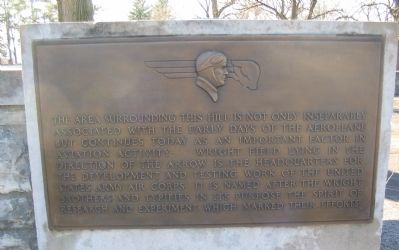
Photographed By Craig Swain, December 26, 2007
5. Southwest Panel
The area surrounding this hill is not only inseparably associated with the early days of the aeroplane but continues today as an important factor in aviation activity. Wright field lying in the direction of the arrow is the headquarters for the development and testing work of the United States Army Air Corps. It is named after the Wright brothers and typifies in its purpose the spirit of research and experiment which marked their efforts.
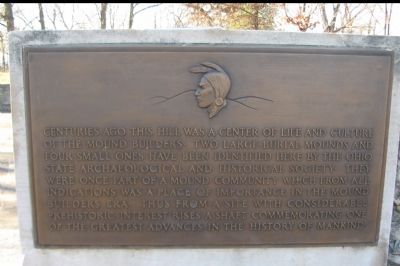
Photographed By Craig Swain, December 26, 2007
6. Northwest Panel
Centuries ago this hill was a center of life and culture of the mound builders. Two large burial mounds and four small ones have been identified here by the Ohio State Archaeological and Historical Society. They were once part of a mound community which from all indications was a place of importance in the mound builders era. Thus from a site with considerable prehistoric interest rises a shaft commemorating one of the greatest advances in the history of mankind.
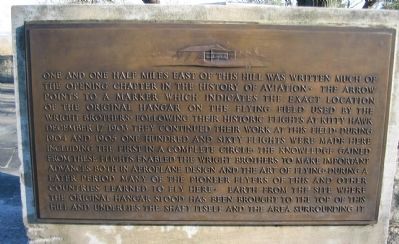
Photographed By Craig Swain, December 26, 2007
7. Southeast Panel
One and one half miles east of this hill was written much of the opening chapter in the history of aviation. The arrow points to a marker which indicates the exact location of the original hanger on the flying field used by the Wright Brothers. Following their historic flights at Kitty Hawk December 17, 1903 they continued their work at this field. During 1904 and 1905 one hundred and sixty flights were made here including the first in a complete circle. The knowledge gained from these flights enabled the Wright brothers to make important advances both in aeroplane design and the art of flying. During a later period many of the pioneer flyers of this an other countries learned to fly here. Earth from the site where the original hanger stood has been brought to the top of this hill and underlies the shaft itself and the area surrounding it.
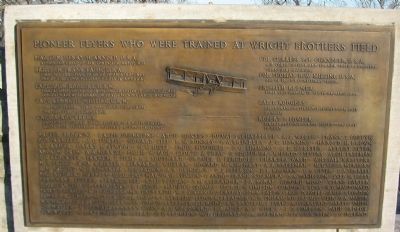
Photographed By Craig Swain, December 26, 2007
8. Northeast Panel
Pioneer flyers who were trained at Wright Brothers Feild
Maj. Gen Henry H. Arnold, U.S.A. Appointed Chief of Air Corps, U.S. Army, 1938
Brig. Gen. Frank Lahm, U.S.A. First military man to go up in an Aeroplane. One of first two military pilots in America
Capt. John Rodgers, U.S.N. First attempted flight from United States to Honduras 1925. Longest made by seaplane to that time - distance 1840 miles
Capt. A. Roy Brown Canadian Royal Air Force, Holder of a distinguished record for outstanding military accomplishment.
Col. Charles DeF. Chandler, U.S.A. Air Corps officer and former Chief of Lighter-than-Air Division.
Col. Thomas DeW. Milling, U.S.A. One of the first military pilots
Griffith Brewer First Englishman to fly in an aeroplane
Cal P. Rodgers First transcontinental flight from east to west
Robert G. Fowler First transcontinental flight from west to east.
Followed by a full listing of those trained by the Wrights.
Maj. Gen Henry H. Arnold, U.S.A. Appointed Chief of Air Corps, U.S. Army, 1938
Brig. Gen. Frank Lahm, U.S.A. First military man to go up in an Aeroplane. One of first two military pilots in America
Capt. John Rodgers, U.S.N. First attempted flight from United States to Honduras 1925. Longest made by seaplane to that time - distance 1840 miles
Capt. A. Roy Brown Canadian Royal Air Force, Holder of a distinguished record for outstanding military accomplishment.
Col. Charles DeF. Chandler, U.S.A. Air Corps officer and former Chief of Lighter-than-Air Division.
Col. Thomas DeW. Milling, U.S.A. One of the first military pilots
Griffith Brewer First Englishman to fly in an aeroplane
Cal P. Rodgers First transcontinental flight from east to west
Robert G. Fowler First transcontinental flight from west to east.
Followed by a full listing of those trained by the Wrights.
Credits. This page was last revised on August 26, 2022. It was originally submitted on January 6, 2008, by Craig Swain of Leesburg, Virginia. This page has been viewed 1,256 times since then and 20 times this year. Last updated on April 27, 2021, by Craig Baker of Sylmar, California. Photos: 1, 2, 3. submitted on April 23, 2021, by Craig Baker of Sylmar, California. 4, 5, 6, 7, 8. submitted on January 6, 2008, by Craig Swain of Leesburg, Virginia. • J. Makali Bruton was the editor who published this page.
